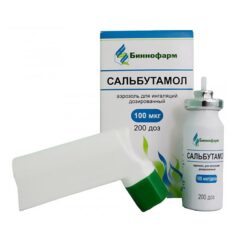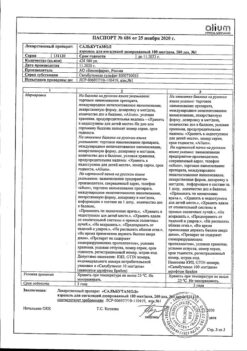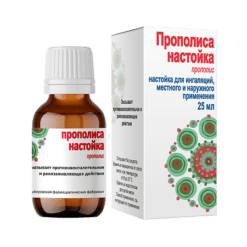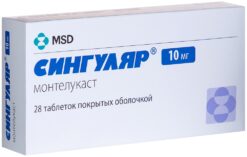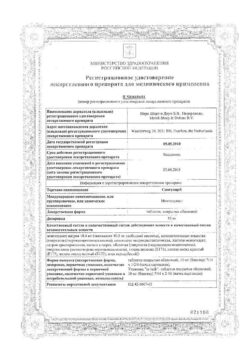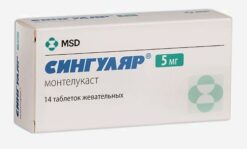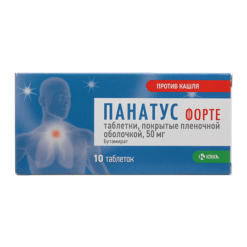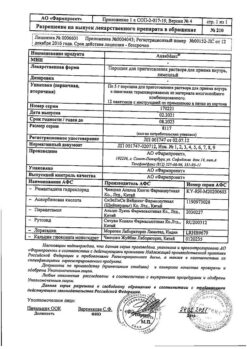No products in the cart.
Bretaris Januair, 322 mcg/dose 30 doses
€1.00
Out of stock
(E-mail when Stock is available)
Description
Clinical efficacy studies have shown that Bretaris Jenaire’ provides clinically meaningful improvement in lung function (as measured by forced expiratory volume in one second [FEF1]) for more than 12 hours after morning and evening administration, which was evident within 30 minutes of the first dose (an increase in FEF1 from baseline of 124-133 mL).
Maximal bronchodilation was achieved within 1-3 hours after the dose with an average peak of improvement in SPH1 relative to baseline of 227-268 mL at equilibrium.
Heart electrophysiology
When acolidinium bromide (200 mcg or 800 mcg) was administered to healthy volunteers once daily for 3 days, no effect on the QT interval (corrected by the Friederitz or Bazette method or individually) was observed.
There was also no clinically significant effect of Bretaris’ Januair® on heart rate in 24-hour Holter monitoring in 336 patients (164 of whom received Bretaris Januair® twice daily at a dose of 322 mcg) after 3 months of using the drug.
Clinical efficacy
. The phase III clinical trial program for Bretaris® Januair® included 269 patients treated with Bretaris® Januair® at a dose of 322 mcg twice daily in one 6-month randomized, placebo-controlled trial and 190 patients treated with Bretaris® Januair® at a dose of 322 mcg twice daily in another 3-month randomized, placebo-controlled trial.
Efficacy was assessed by changes in lung function and clinical symptoms, such as dyspnea, diagnosis-related health status, use of emergency medications, and the presence of exacerbations. In long-term safety studies, Bretaris® Januair® demonstrated bronchodilator efficacy with a duration of use greater than 1 year.
Bronchodilatation
In a 6-month study, patients receiving Bretaris® Januair® at a dose of 322 mcg twice daily had clinically significant improvement in lung function (as measured by RHR]). The maximal bronchodilation effect was evident from day 1 and persisted through the 6-month therapy period of use. After 6 months of therapy, the mean improvement before morning dose (minimum) OEF] compared with placebo was 128 mL (95% CI=85-170; p
Similar observations were made for Bretaris® Genuair® during the 3-month study.
Disease-specific health status and symptomatic improvement
The Bretaris® Genuair® drug provided clinically meaningful improvement in dyspnea (assessed with the Transient Dyspnea Index [TDI]) and disease-specific health status (assessed with the St. George’s Hospital Respiratory Questionnaire [SGRQ]).
Patients who received Bretaris® Januair® required fewer emergency medications than patients who received placebo (0.95 fewer injections per day over 6 months [p=0.005]). Bretaris® Januair® also improved daytime COPD symptoms (dyspnea, cough, and sputum production) as well as nighttime and early morning clinical symptoms.
A pooled efficacy analysis of 6-month and 3-month placebo-controlled studies demonstrated a significant reduction in the incidence of moderate to severe exacerbations (requiring antibiotic or glucocorticosteroid therapy or leading to hospitalization) when taking 322 mcg acolidinium twice daily compared with placebo (frequency per patient per year: 0.31 vs 0.44 respectively; p=0.0149).
Exercise tolerance
In a 3-week randomized, placebo-controlled crossover clinical trial, there was a statistically significant increase of 58 seconds in exercise duration compared to placebo (95% CI=9-108; p=0.021; pre-therapy values: 486 seconds) with Bretaris® Januair®.
A statistically significant reduction in excessive lung overstretch at rest was observed with Bretaris® Januair® (functional residual capacity [FOE]=0.197 L [95% CI=0.321, 0.072; p=0.002]; residual volume [RV]=0.238 L [95% CI=0.396, 0.079; p=:0.004]), and there was an improvement in minimum inspiratory capacity (by 0.078 L; 95% CI=0.01, 0.145; p=0.025) and a decrease in exercise dyspnea (Borg scale) (by 0.63 Borg units; 95% CI= 1.11, 0.14; p=0.012).
Intake
Aclidinium bromide is rapidly absorbed from the lungs, reaching maximum plasma concentration within 5 minutes of inhalation in healthy volunteers, and usually within the first 15 minutes in patients with COPD. The fraction of the inhaled dose that reaches systemic circulation as unchanged acolidinium is very low, less than 5%.
The maximum plasma concentration reached after inhalation of dry powder in patients with COPD at a single dose of 400 mcg acolidinium bromide was approximately 80 pg/mL. Equilibrium plasma concentrations were reached within 7 days when administered twice daily and, given the short elimination half-life, equilibrium concentrations could be reached soon after the first dose. No accumulation at equilibrium concentrations was observed with repeated dosing.
Distribution
The total amount of acolidinium bromide delivered to the lungs via the Bretaris Genuair inhaler was approximately 30% of the measured dose.
The in vitro binding of acledinium bromide to plasma proteins corresponds most likely to the binding of metabolites to proteins; due to the rapid hydrolysis of acledinium bromide in plasma, the binding to plasma proteins was 87% for the carboxylic acid metabolite and 15% for the alcohol metabolite. The main plasma protein that binds acridinium bromide is albumin.
Biotransformation
Aklydinium bromide is rapidly and actively hydrolyzed to its pharmacologically inactive alcoholic derivatives and carboxylic acid derivatives. Both chemical hydrolysis (non-enzymatic) and enzymatic hydrolysis involving esterases take place. The main esterase involved in hydrolysis in humans is butyrylcholinesterase. The level of the acid metabolite in plasma after inhalation is about 100 times higher than the level of the alcohol metabolite and the unchanged active ingredient.
Low absolute bioavailability of acolidinium bromide by inhalation (
Biotransformation with the participation of cytochrome P450 isoenzymes (CYP450) plays a minor role in the total metabolic clearance of acolidinium bromide.
In vitro trials have shown that acolidinium bromide at therapeutic dose or its metabolites do not inhibit or induce any cytochrome P450 (CYP450) isoenzymes and do not inhibit esterase activity (carboxylesterase, acetylcholinesterase and butyrylcholinesterase). In vitro tests have shown that acolidinium bromide or its metabolites are not substrates or inhibitors of P-glycoprotein.
Elimation
The final ionic elimination period of acolidinium bromide is about 2-3 hours.
After intravenous administration of 400 µg of radioactively labeled acolidinium bromide to healthy volunteers, about 1% of the dose was excreted unchanged in the urine.
Up to 65% of the dose was excreted as metabolites in the urine and up to 33% as metabolites in the feces.
After inhalation administration to healthy volunteers and patients with COPD, 200 mcg and 400 mcg of acolidinium bromide, very little, about 0.1% of the dose taken, was excreted unchanged in the urine, indicating that renal clearance plays a minor role in the total blood plasma clearance of acolidinium.
Linearity/nonlinearity
Aklydinium bromide has linear and time-independent pharmacokinetics in the therapeutic range.
Pharmacokinetic/pharmacodynamic relationship
As acolidinium bromide has local action in the lungs and is rapidly broken down in plasma, there is no direct relationship between pharmacokinetics and pharmacodynamics.
Special patient groups
Elderly patients
The pharmacokinetic properties of acolidinium bromide in patients with moderate to severe COPD are similar in patients aged 40 to 59 years and in patients aged 70 years or older. Therefore, no dose adjustment is required in elderly COPD patients.
Patients with impaired liver function
Tests have not been performed in patients with impaired liver function. Because acolidinium bromide is metabolized primarily by chemical and enzymatic breakdown in the plasma, it is very unlikely that impaired liver function alters its systemic effects. No dose adjustment is required in patients with COPD and impaired liver function.
Patients with impaired renal function
In patients with normal and impaired renal function no significant differences in pharmacokinetics have been found. Therefore, no dose adjustment and additional monitoring are required in patients with COPD and impaired renal function.
Aclidinium bromide is a competitive, selective muscarinic receptor antagonist (also called anticholinergic), with longer binding time to Mz receptors than to M2 receptors.
Mz receptors mediate airway smooth muscle contraction. Inhaled acridinium bromide acts locally in the lungs as an antagonist of Mz receptors in the airway smooth muscle and causes bronchial dilation. Preclinical in vitro and in vivo studies have demonstrated rapid, dose-dependent and prolonged inhibition of acolidinium bromide-induced bronchospasm by acetylcholine.
Aclidinium bromide is rapidly broken down in plasma, so the number of systemic anticholinergic side effects is low.
Indications
Indications
No clinical data on the use of acolidinium bromide in pregnant women. Preclinical studies have demonstrated toxic effects on the fetus only at doses many times the maximum therapeutic dose in humans. Aclidinium bromide may be used during pregnancy only if the expected benefit to the mother outweighs the potential risk to the fetus.
Breastfeeding
It is not known whether acolidinium bromide and/or its metabolites penetrate into breast milk in women. Because preclinical studies have shown that small amounts of acolidinium bromide and/or its metabolites penetrate into milk, a decision must be made whether to stop breastfeeding or to discontinue therapy with acolidinium bromide after comparing the benefit of breastfeeding to the baby and the benefit of long-term acolidinium bromide therapy to the woman.
Fertility
Preclinical studies have demonstrated a slight decrease in
Active ingredient
Active ingredient
Composition
Composition
Active ingredient:
aclydinium bromide micronized – 0.400 mg *.
Helpful substance:
α-lactose monohydrate – 12.60 mg.
* One dose contains 400 µg of acolidinium bromide, which is equivalent to 343 µg of acolidinium. This corresponds to a delivered dose of 375 µg of aclydinium bromide, which is equivalent to 322 µg of aclydinium.
How to take, the dosage
How to take, the dosage
Getting to Know Your Bretaris Genuair Inhaler :
Take your Genuair inhaler out of the bag and familiarize yourself with its components.
To use your Bretaris Genuair Inhaler after removing the cap, you need to take 2 steps:
Step 1. Press and release the green button and exhale completely, but not into the inhaler.
Step 2: Hold the mouthpiece tightly around your lips and breathe deeply and strongly through the inhaler.
Don’t forget to wear the protective cap after inhalation.
Start
Before using for the first time, open the sealed bag along the label and remove the Jenuair inhaler
When you are about to take your dose of medicine, remove the protective cap by squeezing the arrows on each side slightly and pulling outward.
Make sure there is nothing blocking the mouthpiece.
Hold the Genuair inhaler horizontally with the mouthpiece facing you, with the green button facing straight up.
Step 1: Press and release the green button.
Do not hold down the green button.
Pause and check; make sure that the dose is ready for inhalation.
Make sure that the color control window is green.
The color control window is green to verify that the medication is ready for inhalation.
If the color control window remains red, press the green button again (see Step 1).
Step 2: Hold the mouthpiece of your Genuair inhaler tightly around your lips and take a strong, deep breath through the mouthpiece.
This strong, deep breath delivers the medicine through the inhaler into your lungs.
Please note: Do not hold the device with the green button down during inhalation.
You will hear a “click” when you inhale, indicating that you are using your Genuair inhaler correctly.
In order to make sure that you have taken the full dose, keep breathing even after you hear the click.
Take your Genuair inhaler out of your mouth and hold your breath as long as you feel comfortable, then slowly exhale through your nose.
Note: Some patients may notice a slight sweet or bitter taste when inhaling this medicine, depending on individual differences. Do not take an additional dose if you do not taste anything after inhalation.
Stop and check: Make sure that you have inhaled correctly.
Make sure that the control window is red. This verifies that you have properly delivered the full dose.
If the color control window remains green, again, take a strong, deep breath through the mouthpiece (see Step 2).
If the window still does not turn red, it is possible that you may have forgotten to release the green button before inhaling, or may have inhaled incorrectly. If this is the case, try again.
Make sure that you release the green button and take a deep, strong breath through the mouthpiece.
Note: If you are still unable to inhale correctly after trying several times, talk to your healthcare professional.
Place the protective cap over the mouthpiece as soon as the window turns red.
When you need a new Jenuair inhaler
The Jenuair inhaler has a dose indicator to tell you how many doses are left in the inhaler. The dose indicator slowly goes down, showing intervals of up to 10 (60, 50, 40, 30, 20, 10, 0). Each Genuair inhaler contains at least 30 or 60 doses, depending on the type of package.
When the red stripes appear on the dose indicator, it means you are nearing your last dose and a new Genuair inhaler must be purchased.
Note: If your Genuair inhaler turns out to be damaged or if you lose the cap, you need to replace your inhaler. You do not need to clean your Genuair inhaler. However, if necessary, it should be done with a dry cloth or paper towel on the outside of the mouthpiece. Never use water to clean your Genuair inhaler as this may damage the medication.
How do I know your Genuair inhaler is empty?
When there is a 0 (zero) in the middle of the dose indicator, you must continue using any remaining doses on your Genuair inhaler.
When the last dose has been prepared for inhalation, the last dose is completely in its up position and will remain locked in the middle position. Even when the green button is locked, you will still be able to take the last dose. After that, your Genuair inhaler cannot be used again and you will need to start using a new Genuair inhaler.
Interaction
Interaction
The concomitant use of acolidinium bromide with other M-cholinoblockers has not been studied and is not recommended.
In spite of the absence of in vivo studies, the use of acolidinium bromide for inhalation is possible in combination with other drugs for the therapy of COPD, including sympathomimetics, bronchodilators, methylxanthines and inhaled or oral GCS.
In vitro studies have demonstrated that acolidinium bromide at therapeutic dose or its metabolites do not interact with drugs that are P-glycoprotein substrates or drugs that are metabolized by cytochrome P450 isoenzymes (CYP450) and esterases.
Special Instructions
Special Instructions
Asthma
Bretaris Jenaire should not be used for asthma; there are no clinical studies on the use of acolidinium bromide for the treatment of asthma.
Paradoxical bronchospasm
As with other inhalation therapy, use of Bretaris Januair may cause paradoxical bronchospasm. If this occurs, Bretaris Genuair should be discontinued and other therapy should be considered.
Acclidinia bromide is intended for maintenance treatment of patients with COPD and should not be used as an emergency therapy. If during treatment with acolidinium bromide, a patient’s COPD symptoms changed and required additional emergency therapy, the patient should be reassessed and the treatment regimen should be reconsidered.
Impact on the cardiovascular system
The cardiovascular safety profile is characterized by the presence of anticholinergic action.
As with other m-cholinoblockers of the drug, Bretaris Generic should be administered with caution to patients who have had a myocardial infarction in the previous 6 months, have unstable angina pectoris, first diagnosed arrhythmias in the previous 3 months, or patients hospitalized for New York Heart Association functional class III and IV heart failure in the previous 12 months, asBecause such patients have been excluded from clinical trials, and anticholinergic effects may affect the course of these diseases.
Anticholinergic effects
The oral mucosal dryness seen with anticholinergic drugs may be associated with the development of tooth decay over time.
In connection with the presence of anticholinergic effects, acolidinium bromide should be prescribed with caution in patients with closed-angle glaucoma (even though direct contact of the drug with the eyes is very unlikely), prostatic hyperplasia and bladder cervical obstruction. Patients should be informed about the signs and symptoms of an acute attack of closed angle glaucoma and the need to discontinue the drug and consult a physician if they occur.
The drug Bretaris Januair is intended for maintenance treatment of patients with COPD. Due to the fact that the general population of COPD patients is substantially dominated by those over 40 years of age, spirometric confirmation of the diagnosis of COPD is required when prescribing the product in patients under 40 years of age.
Impact on the ability to drive vehicles and other mechanisms
Acclidinium bromide may affect the ability to drive vehicles and other mechanisms. Taking into account the possibility of developing such side effects as headache, dizziness, blurred vision, caution should be exercised while driving vehicles, operating other machinery as well as while engaging in potentially dangerous activities requiring increased concentration and rapid psychomotor reactions.
Contraindications
Contraindications
Side effects
Side effects
The most common adverse events with Bretaris Genuair are headache (6.6%) and nasopharyngitis (5.5%).
The frequency of adverse events was based on an estimate of the overall rates of adverse events (i.e., events associated with use of Bretaris Genuair) observed with Bretaris Genuair at a dose of 322 mcg (636 patients) in a pooled analysis of one 6-month and two 3-month randomized, placebo-controlled clinical trials.
The incidence of adverse events has been defined as follows: very common (â¥1/10), common (â¥1/100 to
Infectious and parasitic diseases: common – sinusitis, nasopharyngitis.
Immune system disorders: rare – hypersensitivity reactions; frequency unknown – angioedema.
Nervous system disorders: frequent – headache; infrequent – dizziness.
An organ of vision: infrequent – blurred vision.
Cardiovascular system: infrequent – tachycardia, palpitations.
Respiratory system, thoracic and mediastinal organs: frequently – cough; infrequently – dysphonia.
Gastrointestinal system disorders: frequently – diarrhea; infrequently – dry mouth, stomatitis.
Skin and subcutaneous tissue disorders: infrequent – rash, itching.
Renal and urinary tract: infrequent – urinary retention.
Overdose
Overdose
High doses of acledinium bromide may result in symptoms associated with anticholinergic effects.
However, a single inhaled dose of acledinium bromide up to 6000 mcg in healthy volunteers did not result in systemic anticholinergic side effects. No clinically significant adverse events were observed after 7 days of treatment with acolidinium bromide at doses of up to 800 mcg 2 times daily in healthy volunteers.
The development of acute intoxication in accidental overdose with acolidinium bromide is unlikely due to the low bioavailability with oral administration and inhaled dosing of Bretaris Genuair.
Treatment: symptomatic.
Additional information
| Shelf life | 2 years |
|---|---|
| Conditions of storage | In a light-protected place at a temperature not exceeding 25 °C. |
| Manufacturer | Industrias Pharmaseuticas Almirall S.A., Spain |
| Medication form | metered inhalation powder |
| Brand | Industrias Pharmaseuticas Almirall S.A. |
Related products
Buy Bretaris Januair, 322 mcg/dose 30 doses with delivery to USA, UK, Europe and over 120 other countries.


